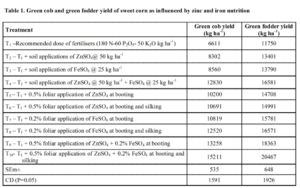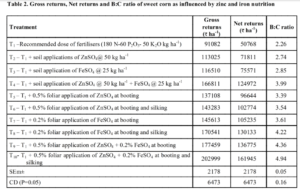YIELD AND ECONOMICS OF SWEET CORN(ZEAMAYS L.)AS INFLUENCED BY ZINC AND IRON FORTIFICATION.
0 Views
ABDUL SHAKOOR KARRIMI*, A. PRATAP KUMAR REDDY, Y. REDDIRAMU AND V. UMAMAHESH
Department of Agronomy, S.V Agricultural College, Tirupati, ANGRAU, Andhra Pradesh, India.
ABSTRACT
A field experiment was conducted during kharif, 2017 to study theyield and economics of Sweet corn(Zea mays L.) as influenced by zinc and Iron fortification. Higher yield of sweet corn was resulted with 0.5 % foliar application of ZnSO4 + 0.2 % FeSO4 at booting and silking along with RDF (N, P2O5 and K2O 180:60:50 kg ha-1) (T10) compared to rest of the treatments. Higher gross, net returns and B:C ratio were recorded with 0.5 % foliar application of ZnSO4 + 0.2 % FeSO4 at booting and silking along with RDF (N, P2O5 and K2O 180:60:50 kg ha-1) (T10). Lower yield and economic returns were observed with recommended dose of fertilizer alone.
INTRODUCTION
Maize (Zea mays L.) is the third most important cereal crop next to rice and wheat in the world’s agricultural economy, both as a food for human and as feed for livestock. It is known as ‘‘queen of cereals’’ because of its maximum yield potential (22 t ha-1) among the cereals and expanded use in different agro-industries. It is recognized as a leading commercial crop of great economic value. It is grown worldwide over an area of 185 million hectares with a production of 1018 million tonnes and productivity of 5.49 tonnes ha-1. In India, it is grown over an area of 9.5 million hectares with a production of 23.3 million tonnes with 2452 kg ha-1of productivity (DACNET, 2014).
Sweet corn (Zea mays L.) also known as sugar corn is a hybridized variety of maize (Zea mays L.) specifically bred to increase the sugar content. The fruit of this plant is the corn kernel which has a sugary rather than a starchy endosperm and a creamy texture.The low starch level makes the kernel wrinkled rather than plumpy. The per capita consumption of sweet corn in the United States during the past 10 years period relatively constant at about 12.7 kg, fresh consumption was about 3.2 kg, while canned corn consumption declined from 6.7 to 5.8 kg and frozen corn consumption increased from 2.6 to 3.7 kg. In India, sweet corn (Zea mays L. saccharata) is confined to meagre area by both farmers and private sectors to meet the demand of industries. Lack of knowledge in its usage, economic importance, non-
availability of appropriate production technology are the major constraints for its popularization among Indian growers. The net income from this crop is quite higher compared to grain maize( Khadtare et al.,2006).
MATERIALS AND METHODS
A field experiment on yield and economics of Sweet corn (Zea mays L.) as influenced by Zinc and Iron fortification was carried out during kharif, 2017 on sandy loam soils of wetland farm of S.V. Agricultural College, Tirupati campus of Acharya N.G. Ranga Agricultural University.
The experiment was laid out in a randomized block design with ten treatments and three replications imposed on sweet corn var cv. Sugar-75. The treatments consisted of RDF alone (180-60-50 kg N, P2O5 and K2O ha -1) (T1), RDF + soil application of ZnSO4 @ 50 kg ha-1 (Basal) (T2), RDF + soil application of FeSO4 @ 25 kg ha-1 (Basal) (T3), RDF + soil application of ZnSO4 @ 50 kg ha-1 + FeSO4 @ 25 kg ha-1) (Basal) (T4), RDF + 0.5% foliar application of ZnSO4 at booting (T5), RDF + 0.5% foliar application of ZnSO4 at booting and silking (T6), RDF + 0.2% foliar application of FeSO4 at booting (T7), RDF +
0.2 % foliar application of FeSO4 at booting and silking (T8), RDF + 0.5% foliar application of ZnSO4 + 0.2% FeSO4 at booting (T9), RDF + 0.5% foliar application of ZnSO4 + 0.2% FeSO4 at booting and silking (T10).
RESULTS AND DISCUSSION
Green cob yield
The higher green cob yield of sweet corn (15211 kg ha-1) (table-1) was recorded with foliar application of 0.5 % of ZnSO4 + 0.2 % FeSO4 at booting and silking along with RDF (N, P2O5 and K2O 180:60:50 kg ha-1) (T10)and was significantly superior over the rest of the treatments tried. It is obvious that the increase in green cob yield is ascribed to the reason that application of zinc and iron along with nitrogen, phosphorus and potassium resulted in vigorous root development, which promotes growth and development of plant leading to higher photosynthetic activity, which inturn results in better development of yield attributes and finally higher seed yield (Paramasivan et al., 2011). These results are corroborated with the findings of Ramachandrappaet al. (2007) and Duraisamiet al. (2007).
Green fodder yield
Green fodder yield of sweet corn was maximum (Table 1) with foliar application of 0.5% of ZnSO4 + 0.2% FeSO4 at booting and silking along with RDF (N, P2O5 and K2O 180:60:50 kg ha-1) (T10), Increase in green fodder yield might be due to the enhanced translocation of photosynthates with applied zinc, which resulted in higher production of green fodder in the respective levels of nutrient. Similar results of significantly higher fodder yield with Zn application was also reported by Mahdi et al.
(2012), Kumar et al. (2013) and Mona (2015).
Economics
The Higher gross (202999 ha-1),net returns (161945 ha-1) and benefit-cost ratio of (Table 2) sweet corn were obtained with foliar application of 0.5% of ZnSO4 + 0.2% FeSO4 at booting and silking along with RDF (N, P2O5 and K2O 180:60:50 kg ha-1) (T 10), which was significantly superior over other treatments tried. The increase in economic returns might be due to increased green cob yield.
CONCLUSION:
The present study revealed that productivity and economics of sweet corn was increased with foliar appli-cation of 0.5% ZnSO4 + 0.2% FeSO4 at booting and silking along with RDF (N, P2O5 and K2O 180:60:50 kg ha-1).
REFERENCES
- DACNET. 2014. Directorate of Economics and Statistics, DAC, Ministry of Agriculture, Govern-ment of India, New Delhi.http:// eands.dacnet.nic.in/stateData_1213Year.htm.
- Duraisami, V.P., Chitdeshwari, T., Subramanian, K.S and Rajeswari, R. 2007.Effect of micronutrients and sulphur on yield and nutrient uptake by Maize in an alfisol. Madras Agricultural Journal.94 (712): 283-288.
- Khadtare, S.V., Patel, M.V., Mokashi, D.D and Jadhav, J.D. 2006. Influence of vermicompost on quality parameters and soil fertility status of sweet corn (Zea mays L. saccharata). Journal of Soils and Crops, 16(2): 384-389.
- Kumar, Ram, H., Dhaliwal SS and Singh, ST. 2013. Productivity and quality of fodder corn (Zea mays L.) under soil and foliar zinc application. Proceedings of XVII International Plant Nutrition Colloquium and Boron Satellite Meeting.752-753.
- Mahdi, S. S., Hasan, B and Singh, L. 2012. Influence of seed rate, nitrogen and zinc on fodder maize (Zea mays) in temperate conditions of western Himalayas. Indian Journal of Agronomy.57 (1): 85-88.
- Mona, E. A. 2015. Increasing Zn ratio in a compound foliar NPK fertilizer in relation to growth, yield and quality of corn plant.Journal of Innovations in Pharmaceuticals and Biological Sciences. 2(4):451-468.
- Paramasivan, M., Kumaresan, K.R., Malarvizhi, S and Velayudham, K. 2011.Effect of different levels of NPK and Zn on yield and nutrient uptake by hybrid maize (COHM 5) in pilamedu and palaviduthi series of Tamil Nadu. Madras Agricultural Journal. 98 (10 – 12): 334-338.
- Ramachandrappa, B.K., Nanjappa, H.V and SoumyaT.M. 2007. Sensory parameters, nutrient content, yield and yield attributes of baby corn varieties as influenced by stages of harvest. Mysore Jour nal of Agricultural Sciences. 41 (1): 1-7.


- Bio-Formulations for Plant Growth-Promoting Streptomyces SP.
- Brand Preference of Farmers for Maize Seed
- Issues That Consumer Experience Towards Online Food Delivery (Ofd) Services in Tirupati City
- Influence of High Density Planting on Yield Parameters of Super Early and Mid Early Varieties of Redgram (Cajanus Cajan (L.) Millsp.)
- Influence of Iron, Zinc and Supplemental N P K on Yield and Yield Attributes of Dry Direct Sown Rice
- Effect of Soil and Foliar Application of Nutrients on the Performance of Bold Seeded Groundnut (Arachis Hypogaea L.)

